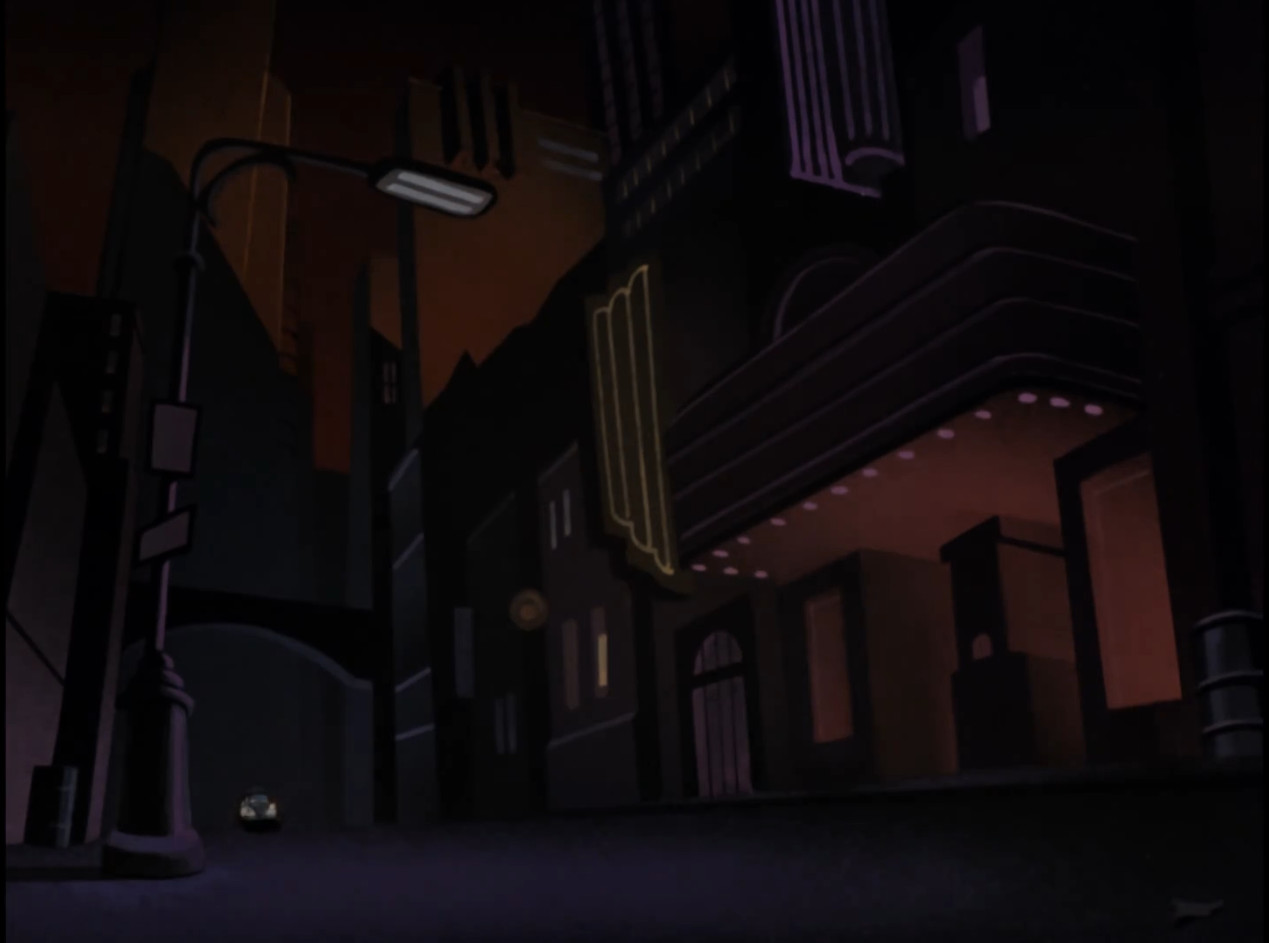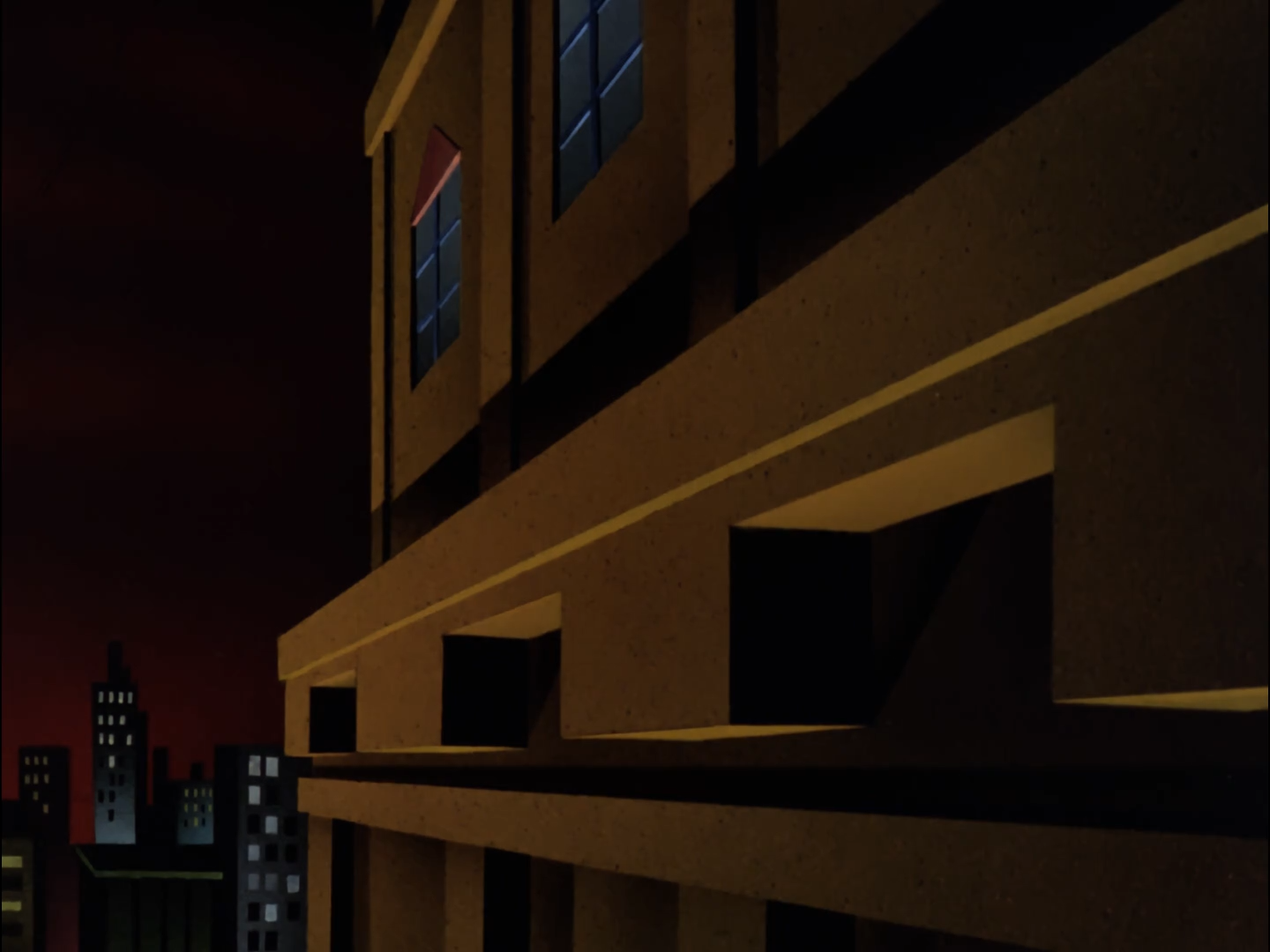How to get ideas using the Design process (MaskedDetecitve Devblog #3)
Hi, I'm working on a stealth game were you play a comicbook detective who uses superpowers to sneak, spy, steal, and escape. Last time I set myself the goal to work on a first test level and blog about it in December. This was a terrible choice given uhhh, its december and I was moving. But now that things are settling down a bit more I can get back to it.
In this blog post I want to start sharing my process of attempting to create this test level, and talk about the power of the Design process.
 (© Warner Bros. Animation)
(© Warner Bros. Animation)
Form Follows Function
Creative tasks like Level Design are plagued with one famous problem; the blank-canvas. The simple lack of knowing what to make. How do you know what to do from infinite options?
In practice the options aren't quite as infinite as they seem. You probably want to make something that at least you consider good, and ideally others do too. Additionally, you're trying to make a good level for your game. Doom's E1M1 is a great level, but it likely wouldn't be a good level for your game. You're also probably not trying to just make any good level for your game but perhaps a good first level, or a good level following a certain twist in the story, or after the introduction of a particular mechanic, etc. These elements constrain the possibilties. You're not just being creative; you're trying to fulfill a need.
This is the essence of Design: "Form Follows Function". Identify the function of what you're creating, and create to fit that need. Now you've gone from what felt like aimlesly considering infinite possibilities to working towards a defined goal. Design isn't some magic of summoning an idea from the void; it's a process, like Science is a process.
Promises and Values
A good place to start thinking about design for a game is to specify the Promises and Values of your game. Promises are the hooks, the pitch, the thing that gets players to play. They are an incredibly important part of the relationship with your audience; without making promises the audience simply doesn't know if they care about what you've made. They want to know if it's something they're interested in. What are my promises? Well I've already been repeating them in this blog series.
- Comic-book feel and aesthetic
- Detective
- Stealth
- Powers
They're simple ideas that can be easily communicated, and someone can instantly start to get a sense of whether or not they're interested. They're very important context for designing your game because if you make some promises to your audience and they don't feel like you fulfilled them, then they're going to find your game very unsatisfying. In fact the same piece of content with a different promise can receive radically different appraisals from the same people.
Values are different; they are more nuanced. They're not really meant to be in marketing material, instead they are opinions about how your game should be. They're a philophy. A subjective taste or a theory on how to make something good. Sometimes they're near universally accepted theories such as "the main character of a story should have goals and things they care about". They constrain and guide you. Here are some values for this game:
- Feel sneaky even after being discovered
- (I cover this as a problem I have with stealth games in the first blog post)
- Every mission is a story.
- They should be surprising, develop in complexity, unfold.
- The levels should say something about the fictional world.
- Exploration is key
- You should generally be at least a little non-linear.
- Navigate without UI markers or a map screen.
- I really dislike pausing to check the map screen in Thief, it ruins the flow of the game. As much as possible I want the player to be able to orient themselves using cues from the environment. And probably just remove the map screen entirely.
- Every Level should have a unique identity, and have its own hook and interest
By identifying my Promises and Values, I now have a lot of context to feed into this test level.
Level Function
So, what's the function of this level I'm making? There's a number of things I want to achieve.
- Show off all the promises of the game
- I need to test that I can deliver on the promises. Ideally this is also a hypothetical "first level" for the final game (unlikely to end up being so in reality) and a good idea for a first level in a game is to do a little bit of all of your promises. Allow people to understand what the game is really about.
- Teach the basic gameplay, including the memory erase feature
- The memory erase feature is meant to be a big value of the game and a core part of the gameplay loop, the player absolutely needs to learn it.
- Introduce a world and a setting
- Be surprising. Wow the player a little.
- Interest the player in seeing more of the game.
By fleshing out these requirements I can start turning my task from "Make a level" into the more specific task of "Make a level with these particular properties." I'll try making a list.
- Things to communicate
- The player is a vigilante detective
- The world does not look kindly on vigilante detectives
- The big corps of the world are in-fighting. Having successfully co-opted or suppressed regulators and unions their only opposition is now each other.
- Key moments
- Feel very sneaky
- Use some cool powers
- Discover something and feel like a detective.
- A "twist". A moment where everything gets a bit more complex. Things can't just go according to expectations. Ideally this moment changes the pacing of the level, which also often means the gameplay.
- Things the player must learn
- The basic controls
- How to sneak
- How to interact with objects
- How to erase memories
- Some key details
- The player should always have some kind of goal, give them a mission statement right away. But as mentioned above, there needs to be a twist, there should be more to it than the original goal.
- A feeling of mystery
- Feel like a comic-book, or specifically Batman the Animated Series.
- Some non-linearity, to help you feel like you're exploring.
- Has a unique identity. Something about it that no level after it would be allowed to do.
With this list I can begin to brainstorm specific ideas of how to do each of these things, and build things into a layout.
When you look at this list you can begin to identify some things that seemingly must be true. I have some things the player must learn, which means they probably need to be the first things in the level and there needs to at least be a bottle neck to prevent you from getting into the meat of the level without learning those. This "comic book" or "Batman the Animated Series" specific feel is interesting. I really associate BTAS with its cityscapes, which really suggests I should do a cityscape level. Which could be the unique identity this level gets to have. I probably don't want to do too many cityscape levels.
For it to be a cityscape there needs to be multiple buildings. So I probably need to avoid putting the player into one specific building for too much of the level. And should probably make use of a lot of big windows, balconies, walkways, and rooftops. If you are going between multiple buildings I probably want there to be some cohesion between these buildings world-building wise. Ideally I want things in some building to relate to things in another building. And I probably want the player to feel like all the buildings collectively make the level a single shared space, rather than just the levels being a series of individual buildings you break into one after another.
In terms of the relationship between buildings, I do have an option here I can pull from else where in the list: "The big corps of the world are in-fighting" perhaps this is some CBD area of a big city and there's several competing corps all within a block or two of each other, and your infiltration into these buildings leads to you realizing the extent of the rilvary between these companies. Perhaps even between their owners as people. I can put penthouses in as a neat difference in space and to pull in those more personal elements of their owners or employees. And while I do want the buildings to have a story relationship, I don't want them all to look the same; each company could have its own architecture aesthetic or interior design aesthetic.
For the "twist" or big pace change, I can again look to that rilvary. What if one corp secretly hired a group to kidnap the head of another? They'll make it look like environmentalists or "Extremist Unionists" or whatever. Notably, if this happens while the player is in the building, then the security situation in that building instantly changes. Everyone is on high alert, which makes things very hard for you. But also you have a big corporate secret to try and find proof of.
There is an upside to moving this beat forward a bit into the level: perhaps the victim knows it's bullshit, and says something like "Who hired you? Was it <competitor name>? Maybe <another name>?" and this sets up the player to break into the near by competitors and identify which one has organized the kidnapping. This gives the player goals and can create some obvious non-linearity potential. However I probably want the increased security to be something later in the level. Perhaps the player has to circle back and when they get back, the kidnapping has been discovered by the personal security of the victim and a conflict is escalating. That sounds like it could work.
The above is a great example of the Design process in action. I identified the function of my level, and from only a few of those specific goals I have derived a setting or "stage" I guess you might call it, some basic plot, and a loose structure for the level. I went from a blank canvas to a sketch. Still a lot of work to do, but a big hurdle is overcome.
If you'd like to hear more about this sort of process from someone with real professional Level Design experience, you should check out videos from Steve Lee, who I've found extremely helpful.
Dev planning!
So what's next? The near-term goals are still:
- Get a few powers in
- Make a test level
This process has helped a bit with the first one: if I want to enable some rooftops gameplay, I may need abilities that specifically help with that. The second one still needs more design work, so the next post will simply be further refinement on this idea, and some early work thinking about the level layout.
 (© Warner Bros. Animation)
(© Warner Bros. Animation)
Follow along
You can follow this project via RSS (Don't know RSS?), or by following me on Mastodon. And of course feel free to contact me via email, or Mastodon with any comments or questions.